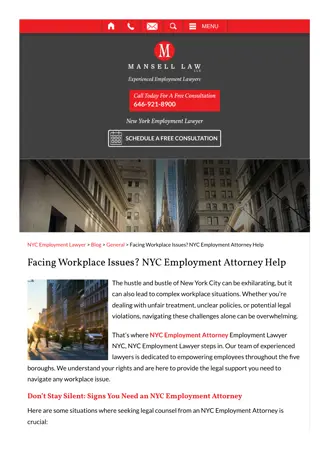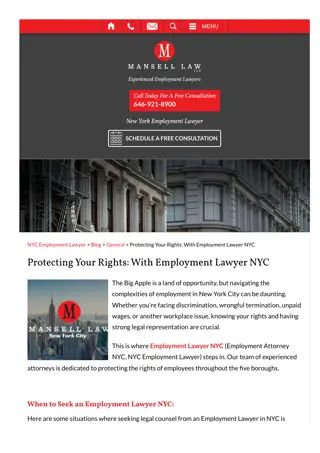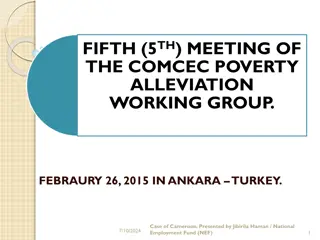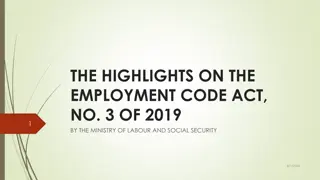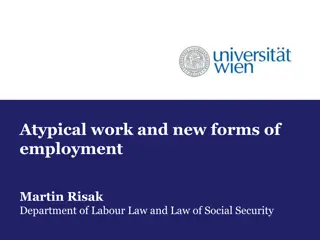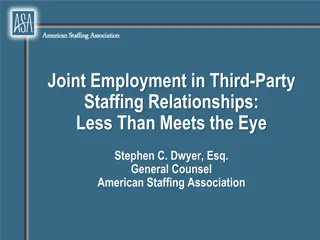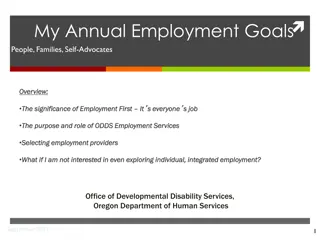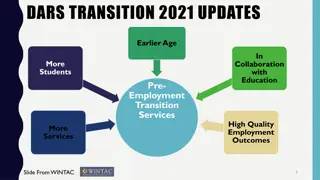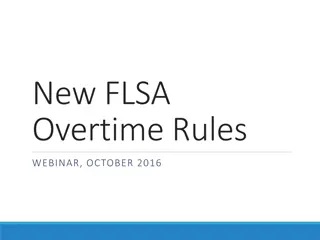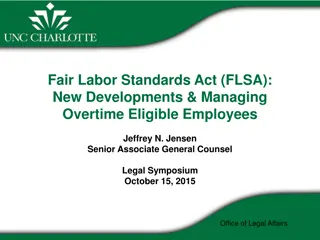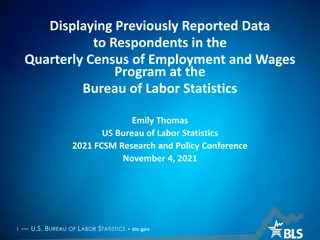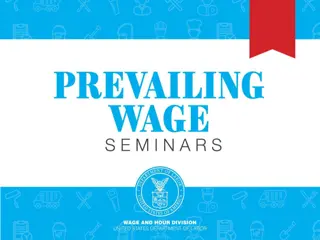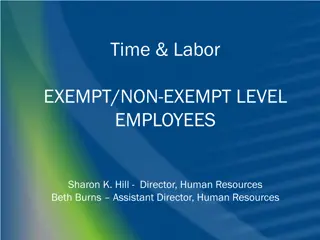Understanding Employment Relationships Under the FLSA
Employment relationships under the Fair Labor Standards Act (FLSA) are crucial for determining the applicability of minimum wage and overtime pay provisions. The FLSA defines "employ" as to suffer or permit to work, establishing the basis for distinguishing between employees and independent contractors. Misclassification of workers can lead to denial of crucial benefits and protections, highlighting the importance of correctly classifying workers. There is no definitive test for determining employee status, with economic dependency on the employer being a key factor.
Download Presentation

Please find below an Image/Link to download the presentation.
The content on the website is provided AS IS for your information and personal use only. It may not be sold, licensed, or shared on other websites without obtaining consent from the author. Download presentation by click this link. If you encounter any issues during the download, it is possible that the publisher has removed the file from their server.
E N D
Presentation Transcript
Employment Relationship Under the FLSA
Contents 1. FLSA Definitions 2. Suffer or Permit Standard 3. The Problem: Misclassification 4. Employee or Independent Contractor? Economic Realities Test Overarching Considerations 5. Additional Information
FLSA Definitions In order for the FLSA s minimum wage and overtime pay provisions to apply, an employment relationship must exist between the employer and the worker (the worker must be an employee ). The FLSA s definition of employ includes to suffer or permit to work.
FLSA Definitions The MSPA and the FMLA incorporate the FLSA definition of employ. FLSA employment relationship concepts also apply to questions about whether a worker is an employee or independent contractor under the MSPA and the FMLA.
Suffer or Permit Standard The FLSA definition of employ, which includes to suffer or permit to work, was specifically designed to broadly cover as many workers as possible. Most workers are employees under the FLSA.
The Problem: Misclassification A common problem arises where employers misclassify workers who are employees under the law as independent contractors. Studies suggest that 10 to 30 percent of employers may misclassify their employees as independent contractors.
The Problem: Misclassification Workers misclassified as independent contractors are wrongfully denied access to important benefits and protections, such as: Minimum wage and overtime pay Workers compensation Family and medical leave Misclassified employees may still be eligible for unemployment insurance, but misclassification complicates their ability to collect these benefits.
Employee or Independent Contractor? There is no single test for determining whether a worker is an employee (like most workers) or an independent contractor under the FLSA. A worker is an employee if he or she is economically dependent on the employer, whereas a worker is an independent contractor if he or she is in business for himself or herself.
Employee or Independent Contractor? The economic reality of the worker s relationship with the employer determines whether the worker is economically dependent on the employer (and therefore, an employee) or is in business for himself or herself (and therefore, an independent contractor). Courts generally apply a number of economic realities factors as guides when making the determination, but the factors applied can vary and no one set of factors is exclusive.
Overarching Considerations No single economic realities factor determines whether a worker is an employee or an independent contractor. The six factors discussed in this presentation are not exclusive. Courts may consider additional factors that shed light on whether a worker is an employee or an independent contractor.
Overarching Considerations The factors should not be applied as a checklist or scorecard. What matters is whether the totality of the circumstances indicates the worker is an employee or independent contractor.
Economic Realities Factors We generally consider the following factors when determining if a worker is an employee or independent contractor: 1. 2. Is the work an integral part of the employer s business? Does the worker s managerial skill affect his or her opportunity for profit and loss? Relative investments of the worker and the employer The worker s skill and initiative The permanency of the worker s relationship with the employer Employer control of employment relationship 3. 4. 5. 6.
Work Integral to the Business Work is integral to the employer's business if it is a part of the production process or is a service that the employer is in business to provide. If the work performed is integral to the employer s business, the worker is more likely economically dependent on the employer.
Work Integral to the Business For example, the work of a carpenter is integral to the operation of a construction company because the company is in the construction business and the carpenter performs the construction on behalf of the company. On the other hand, a worker engaged by the construction company to repair its copier is not performing work that is integral to its business.
Managerial Skill for Profit/Loss This factor should focus on the worker s managerial skill and whether this skill affects the worker s profit and loss. The issue is not whether the worker possesses skills, but whether the skills are managerial and suggest that the worker is operating as an independent business.
Managerial Skill for Profit/Loss Managerial skills that suggest independent contractor status include the ability to make independent business decisions, such as deciding to make business investments or hire helpers. Deciding to work more jobs or longer hours is not such a business decision. When analyzing this factor, it is also important to consider whether the worker faces a possible loss as a result of these independent business decisions.
Relative Investment The worker must make some investment (and undertake some risk for a loss) to indicate he or she is an independent business. Merely purchasing tools to perform a particular job is not a sufficient investment to indicate an independent business. The worker s investment must also compare favorably with the employer s investment to suggest the worker is an independent contractor.
Relative Investment A worker s investment compares favorably when: The investment is substantial and The investment is used for the purpose of sustaining a business beyond the job or project the worker is performing.
Skill and Initiative Both employees and independent contractors may be skilled, even highly skilled, workers. Specialized skills, such as computer programming, do not necessarily indicate independent contractor status. To suggest the worker is an independent contractor, the skills should demonstrate that the worker exercises independent business judgment or initiative.
Permanency of the Relationship A permanent or indefinite relationship with the employer suggests the worker may be an employee. However, the absence of a permanent or indefinite relationship does not automatically indicate the worker is an independent contractor.
Permanency of the Relationship What matters is whether the impermanence is a result of: The worker s choice (which suggests independent contractor status) or The structure of that particular industry or employer (which may indicate the worker is an employee).
Control An independent contractor typically works relatively free from control by an employer (or anyone else, including the employer s clients). This factor includes who controls: Hiring and firing, The amount of pay, The hours of work, and How the work is performed.
Control The employer s lack of control does not automatically indicate the worker is an independent contractor. An employer can still exercise control over the worker even if the worker teleworks or works offsite.
Control To be considered an independent business, the worker must also exercise control over meaningful aspects of the work.
Additional Information For more information, please: Visit WHD s website at http://www.dol.gov/whd Call WHD s toll-free helpline, available 8 a.m. to 5 p.m. in your time zone, at 1-866-4USWAGE (1-866-487-9243) For questions about 1099s and the tax status of employees versus independent contractors, please: Visit the IRS website at http://www.irs.gov


